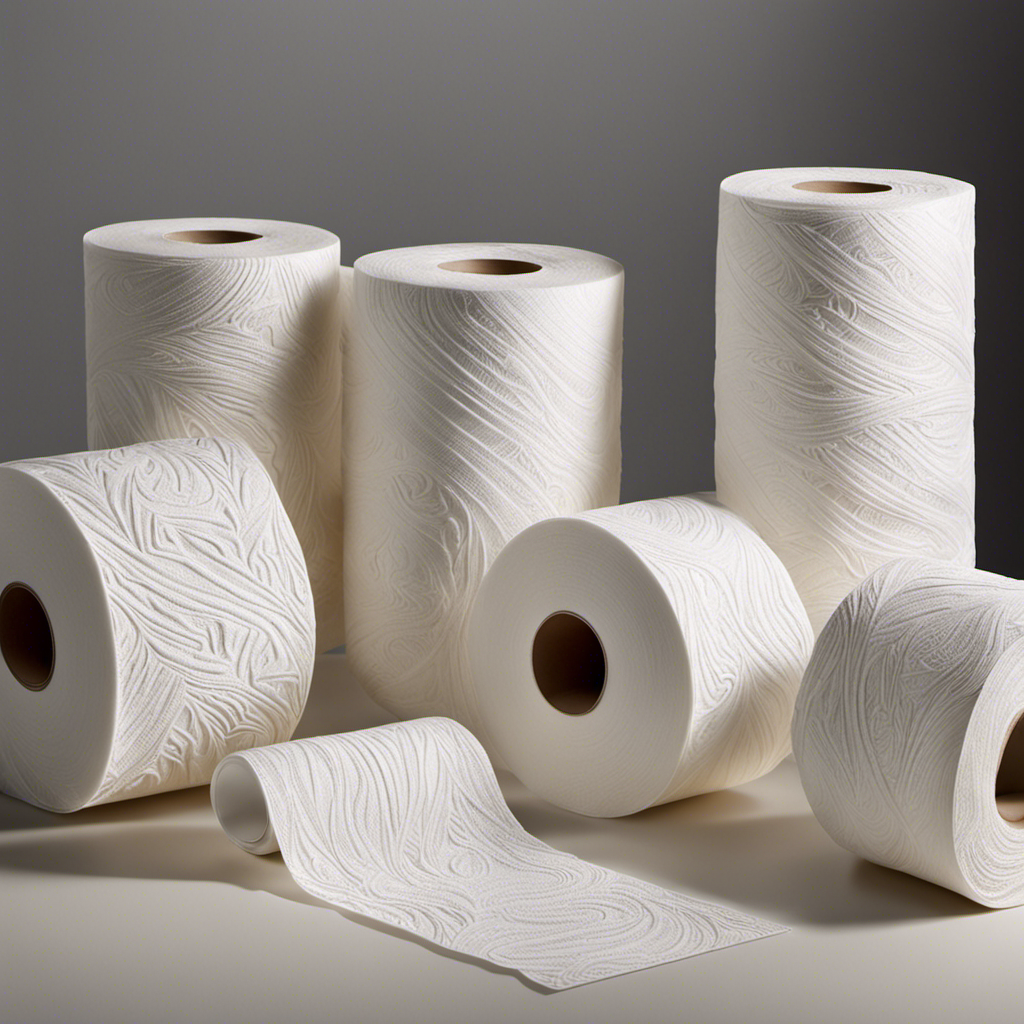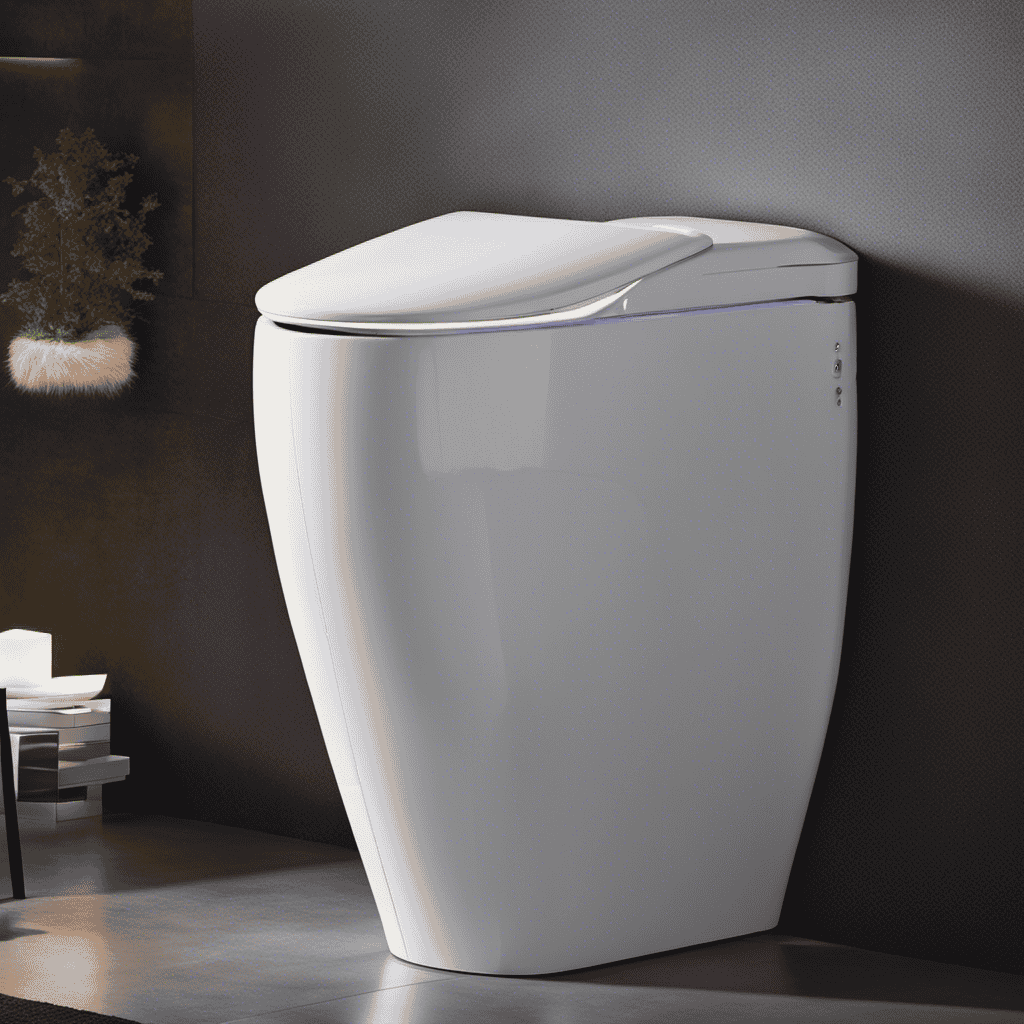As I unwrap a fresh roll of toilet paper, I often wonder about the mysterious ingredients that make it so soft and absorbent. Have you ever wondered what goes into the manufacturing process of this essential bathroom staple?
In this article, we will delve into the world of toilet paper production and explore the types of fibers, chemicals, and additives used.
Additionally, we will discuss the environmental impact of traditional toilet paper and explore sustainable alternatives.
Get ready to unravel the secrets behind what is in toilet paper!
Key Takeaways
- Toilet paper is made from a mixture of wood fibers and water, which are chemically broken down and then pressed and dried to form sheets.
- The production of toilet paper has a significant environmental impact, including deforestation, carbon emissions, soil degradation, and water quality issues.
- Sustainable alternatives, such as recycled paper or bamboo-based products, can help reduce the environmental impact of toilet paper production.
- Factors affecting the softness and strength of toilet paper include fiber composition, ply and thickness, additives, and manufacturing processes. It is important to avoid harmful chemicals and additives in toilet paper.
Manufacturing Process of Toilet Paper
To make toilet paper, you’ll start with a mixture of wood fibers and water. The manufacturing techniques involved in producing toilet paper are quite fascinating.
The process begins by breaking down the wood fibers into a pulp using chemicals and heat. This pulp is then mixed with water to create a slurry.
The slurry is spread onto a wire mesh screen, where the water is drained away, leaving behind a thin layer of fibers. The fibers are then pressed and dried to form the familiar soft and absorbent sheets of toilet paper.
Quality control is an essential aspect of the manufacturing process. Each batch of toilet paper undergoes rigorous testing to ensure it meets the necessary standards for strength, softness, and absorbency.
This ensures that you get the best quality product for your bathroom needs.
Ingredients Used in Toilet Paper Production
You might be curious to know what materials are used to make toilet paper. The production process of toilet paper involves a few key ingredients.
The main ingredient is wood pulp, which is derived from trees such as pine or spruce. This wood pulp is processed and bleached to create the soft, white paper that we use.
Additionally, toilet paper may also contain other ingredients such as water, chemicals for softening or strengthening the paper fibers, and dyes for color. These ingredients are carefully selected and combined in the manufacturing process to create the final product that we see on store shelves.
Now, let’s discuss the environmental impact of toilet paper production and how it affects our planet.
Environmental Impact of Toilet Paper Production
As someone who’s passionate about environmental sustainability, I’m deeply concerned about the deforestation caused by toilet paper production. It’s estimated that millions of trees are cut down each year to meet the global demand for this everyday product.
However, there are alternatives available that can help reduce waste and the environmental impact of toilet paper production.
Deforestation for Toilet Paper
Don’t underestimate the impact of deforestation for toilet paper production. It may seem like a small thing, but the consequences are significant. Here are three reasons why deforestation for toilet paper should concern us:
-
Loss of biodiversity: When forests are cleared for toilet paper production, countless plant and animal species lose their habitats. This leads to a decrease in biodiversity and can disrupt entire ecosystems.
-
Increased carbon emissions: Trees absorb carbon dioxide, a greenhouse gas that contributes to climate change. Deforestation releases this stored carbon back into the atmosphere, exacerbating global warming.
-
Soil degradation and erosion: Forests help to maintain healthy soil by preventing erosion and promoting nutrient cycling. When trees are removed, the soil becomes vulnerable to degradation and erosion, affecting agriculture and water quality.
To combat these issues, it’s essential to consider sustainable alternatives to traditional toilet paper, such as recycled paper or bamboo-based products. By making conscious choices, we can help protect forests and reduce the environmental impact of toilet paper production.
Alternatives to Reduce Waste
There’s a variety of sustainable options available to lessen waste and minimize environmental impact.
One option is adopting a minimalist lifestyle, which focuses on owning only the essentials and reducing overall consumption. By simplifying our lives and purchasing only what we truly need, we can significantly reduce waste.
Another option is to switch to compostable toilet paper. Traditional toilet paper contributes to deforestation and takes a toll on the environment. However, compostable toilet paper is made from renewable resources like bamboo or recycled paper, which helps minimize waste and reduce the carbon footprint. It can also be safely composted, returning valuable nutrients back to the soil.
Making these small changes in our daily lives can have a big impact on reducing waste and preserving our environment.
Types of Fibers Used in Toilet Paper
When it comes to the types of fibers used in toilet paper, there are a few common sources to consider.
Some of the most common fiber sources include virgin wood pulp, recycled paper, and bamboo. Each of these sources have different environmental impact considerations, such as deforestation for virgin wood pulp, energy and water usage for recycled paper, and the sustainability of bamboo.
Additionally, the choice of fiber source can also impact the softness and strength factors of the toilet paper, with some fibers being naturally softer or stronger than others.
Common Fiber Sources
One of the common fiber sources in toilet paper is recycled paper. This sustainable sourcing method helps reduce the reliance on virgin wood pulp, which is obtained by cutting down trees. By using recycled paper, we can help preserve our forests and minimize the environmental impact of toilet paper production.
In addition to recycled paper, toilet paper may also contain other fiber types such as:
-
Bamboo: Known for its fast growth and abundant availability, bamboo is a popular choice for sustainable toilet paper. It requires less water and fewer pesticides compared to traditional wood pulp.
-
Sugarcane: Another eco-friendly option, sugarcane fiber is obtained from the byproduct of the sugar refining process. It is a renewable resource and helps reduce waste.
-
Hemp: Hemp fiber is durable and can be grown without the need for pesticides or fertilizers. It is a highly sustainable option for toilet paper production.
Considering the various fiber types and sustainable sourcing methods used in toilet paper production, it is important to also understand the environmental impact of this everyday essential.
Environmental Impact Considerations
Consider the environmental impact of using sustainable fiber sources in your everyday essentials. When it comes to manufacturing techniques, opting for sustainable fibers can significantly reduce the negative impact on our planet. Traditional methods often involve a high amount of water and energy consumption, as well as the use of harmful chemicals. In contrast, sustainable manufacturing techniques prioritize waste reduction and minimize the use of resources. This not only helps to conserve our natural resources but also reduces pollution and carbon emissions. By choosing products made from sustainable fiber sources, we can contribute to a healthier and more sustainable environment.
Now, let’s delve into the factors of softness and strength, which are crucial when it comes to selecting the perfect toilet paper.
Softness and Strength Factors
After considering the environmental impact of toilet paper production, it’s important to delve into the softness and strength factors that come into play.
When it comes to softness, there are a few key factors to consider:
- Fiber composition: Toilet paper made from fibers like virgin pulp or bamboo tend to be softer compared to recycled paper.
- Ply and thickness: Toilet paper with more plies and thickness generally feels softer and more luxurious.
- Lotion or additives: Some brands add lotions or additives to enhance softness and provide a more gentle feel.
In terms of strength, these factors play a crucial role:
- Fiber length and quality: Longer and higher quality fibers contribute to a stronger toilet paper.
- Wet strength additives: Some manufacturers incorporate wet strength additives to improve the paper’s strength when wet.
- Manufacturing process: Properly processed toilet paper with well-bonded fibers is less likely to tear or break easily.
Chemicals and Additives in Toilet Paper
You should be aware of the chemicals and additives present in your toilet paper.
Many toilet papers contain toxic chemicals such as chlorine, formaldehyde, and fragrance additives. These chemicals can pose serious health concerns, especially for those with sensitive skin or respiratory issues.
Chlorine is often used in the bleaching process of toilet paper, which can lead to skin irritation and respiratory problems when exposed to the skin or inhaled.
Formaldehyde, a known carcinogen, can be found in toilet paper as a preservative.
Fragrance additives, although they may provide a pleasant scent, can also cause skin irritation and allergic reactions.
Therefore, it is important to choose toilet paper that is free from these harmful chemicals and additives, opting for natural and hypoallergenic options to protect your health.
How Toilet Paper Is Made Soft and Absorbent
As I mentioned earlier, the chemicals and additives in toilet paper play a role in its overall quality. Now, let’s delve into how toilet paper is made soft and absorbent.
Toilet paper production techniques have evolved over the years, with manufacturers constantly seeking innovations in toilet paper technology. Here are three key factors that contribute to the softness and absorbency of toilet paper:
-
Fiber selection: High-quality toilet paper is typically made from virgin wood pulp or a blend of virgin and recycled fibers. The selection of the right fibers ensures a soft and plush texture.
-
Paper machine technology: Advanced paper machines use techniques like water jetting and air drying to create a delicate and fluffy toilet paper. These technologies help enhance the softness and absorbency of the final product.
-
Embossing and ply layers: Adding embossed patterns and increasing the number of ply layers can make the toilet paper softer and more absorbent.
Now that we understand how toilet paper is made, let’s explore sustainable alternatives to traditional toilet paper.
Sustainable Alternatives to Traditional Toilet Paper
When considering sustainable alternatives, it’s important to explore options that prioritize environmental friendliness and reduce waste.
One such option is using toilet paper made from sustainable materials and compostable options.
Sustainable materials, such as bamboo or recycled paper, are increasingly being used to make toilet paper. These materials are renewable, meaning they can be replenished without causing harm to the environment.
Additionally, compostable options are becoming more popular. These toilet papers are designed to break down quickly and easily, allowing them to be composted along with other organic waste.
Frequently Asked Questions
Can Toilet Paper Be Recycled?
Yes, toilet paper can be recycled. However, it’s important to note that using toilet paper alternatives like bidets or reusable cloths can greatly reduce the environmental impact of toilet paper production.
Are There Any Health Risks Associated With Using Toilet Paper?
There are no health risks associated with using toilet paper. In fact, it provides convenience and hygiene benefits. However, there are alternative options like bidets or reusable cloth wipes that are more eco-friendly.
How Long Does It Take for Toilet Paper to Decompose?
Toilet paper takes about 1-3 years to decompose, depending on various factors like moisture and temperature. The manufacturing process uses wood pulp and chemicals, which contribute to the environmental impact of production.
Is Toilet Paper Safe for Septic Systems?
Toilet paper is safe for septic systems as long as it is labeled as septic-safe. Proper septic tank maintenance is crucial to prevent clogs. If concerned, there are alternative options like bidets or reusable cloth wipes.
What Is the Average Usage of Toilet Paper per Person per Year?
On average, I use about 100 rolls of toilet paper per year. Considering the average consumption of toilet paper per person, it’s crucial to be aware of the environmental impact and choose sustainable options.
Conclusion
As I conclude my exploration into the world of toilet paper, I am struck by the symbolism it holds.
This humble product, crafted from various fibers and chemicals, represents our society’s need for comfort and cleanliness.
But it also carries a weight of responsibility towards our environment. We must seek sustainable alternatives to traditional toilet paper, ones that prioritize the health of our planet.
Let us not overlook the depth and complexity that lies within a simple roll of toilet paper, for it holds the potential to shape our future.










